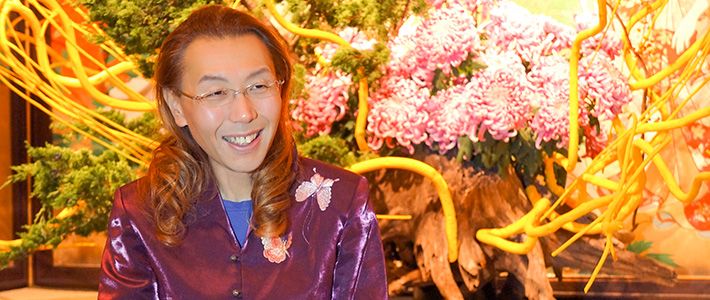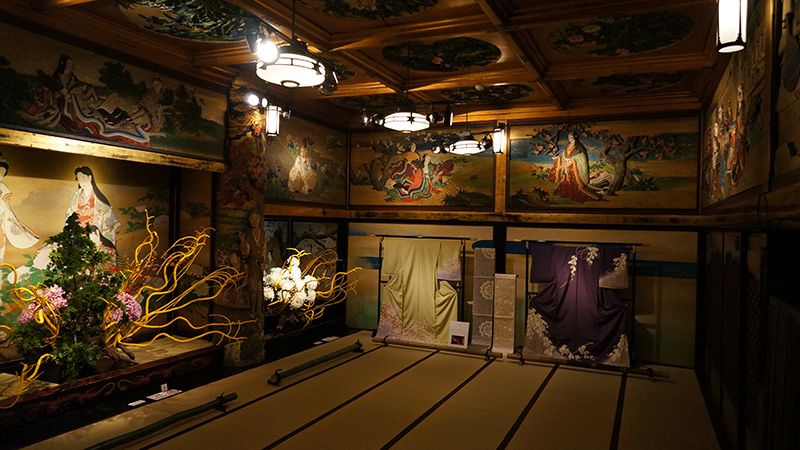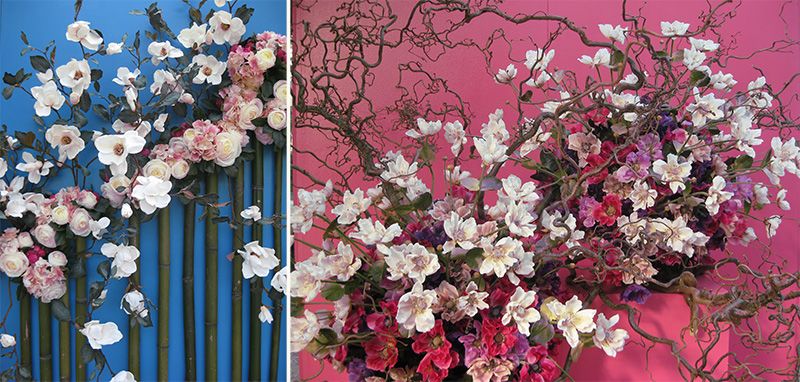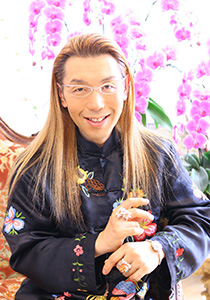
Giving a Flowering Art a New Arrangement
Culture Lifestyle- English
- 日本語
- 简体字
- 繁體字
- Français
- Español
- العربية
- Русский
The Importance of Self-Promotion
INTERVIEWER Your unique creations displayed in Japan and abroad are a different take on the traditional Japanese flower arranging, ikebana. How would you describe your style?
KARIYAZAKI SHŌGO The foundation for my style is the traditional ikebana, but I try to add original, modern elements as well. I use flowers to try and express something that is unique to me and my personality. Many Japanese individuals find it hard to sell themselves as individuals in that way; whereas outside Japan people are more adept at promoting themselves.
 The “Kariyazaki Shōgo’s World—A Flower Renaissance“ exhibition of flower arranging was open to the public at Meguro Gajoen in Tokyo’s Meguro Ward until November 18, 2012.
The “Kariyazaki Shōgo’s World—A Flower Renaissance“ exhibition of flower arranging was open to the public at Meguro Gajoen in Tokyo’s Meguro Ward until November 18, 2012.
Perceptions Abroad
INTERVIEWER In the case of traditional Japanese flower arranging, flowers are cut and displayed in a very simple way. How do people outside Japan react to that approach?
KARIYAZAKI People overseas often say that ikebana is the ultimate in minimalism because a single flower on a single stem is all it takes. The art is in harmony with the sort of nebulous, indeterminate beauty often found in Japanese spaces, such as the soft light that streams through a paper-screened door. Placing a beautiful lone flower against that sort of backdrop allows for a clear appreciation of its beauty. This Japanese aesthetic has been passed down from generation to generation.
For ikebana, each flower is trimmed to the point beyond which nothing else should be taken away. This is quite different from the flower arranging seen in other countries, where the approach is to add more and more layers of flowers. When people from such countries see ikebana, I think it often strikes them as a fresh, new approach.
A Tool for Communication
INTERVIEWER You are playing an important role in promoting Japan around the world. What are your thoughts and feelings on how flower arranging can be used to enhance cross-cultural understanding?
KARIYAZAKI Around the world you can see how important flowers are to people’s lives. There are so many uses for flowers, whether it be for decorating a house or to give someone as a present. I really think that Japan lags behind in this respect—just as there are many other areas where Japan has room for improvement. However, there are so many people abroad who find Japanese culture interesting and I do my best to convey to them what I know.
I also think it’s extremely important for me to use flowers as a vehicle for communicating with other people. Of course, you can understand a lot by just looking at flowers, but I find that adding some explanation enhances their understanding and brings us closer together. Since Japan is an island country, it tends to be rather isolated. So I hope that communicating through the use of flowers will be a way to bring Japanese closer to people in other countries.
 Flower arrangements created by Kariyazaki for an exhibition held in Paris in the summer of 2012.
Flower arrangements created by Kariyazaki for an exhibition held in Paris in the summer of 2012.
INTERVIEWER When presenting your creations to the public do you find differences between how they are received in Europe compared to Asia?
KARIYAZAKI I think there are big differences; particularly when it comes to use of color. In Asia, yellows and reds are very popular. These colors are associated with good fortune so when I use them, people are always delighted. In the Europe, when I use elegant colors, like an exquisite pink or purple, I often get a wonderful reaction, with people telling me how much they like the subtlety and profundity of the flowers.
Importance of Art Appreciation
INTERVIEWER Your business related to flower arranging has been very successful. How do you feel about this side of things?
KARIYAZAKI I think there is still a lot of room for improvement, but my basic hope is that my customers will enjoy the events I organize. It’s important to have the notion of people paying their own money for such cultural events—just as in the case of museums, concerts, movies, or restaurants. People say that the economy is in bad shape these days but crying about it won’t solve anything. If we can find a framework in which people use their pocket money in exchange for the beautiful things in life, it will reinvigorate Japan’s economy. It’s something that everyone has to get involved in, and I’d like to do what I can to offer people something worthwhile.
(Translated from an interview in Japanese by Harano Jōji, representative director of the Nippon Communications Foundation.)
Click on the video below to see flower arrangements from the “Kariyazaki Shōgo’s World—A Flower Renaissance“ exhibition
